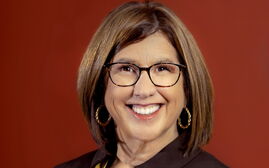
Hug or a handshake: 10 guidelines for business greetings
I wrote a column for Mainebiz on the same topic in 2018, but a lot has changed since then.
Because of the long period of forced isolation, the pandemic made people less social, more distant and hesitant about physical touch in the workplace.

You may be comfortable hugging friends, but the same rules do not apply for hugging colleagues or clients at work. Understanding the nuances of hugging etiquette at work is crucial.
A survey by Total Jobs revealed that 76% of respondents wish for reduced physical contact in the workplace, with 15% advocating for a complete ban on hugging. Instances of awkward hugging mishaps, such as unwanted embraces or accidental headbutts, underscore the complexity of hugging in professional settings.
I am the kind of person who is enthusiastic about greeting people. But since the pandemic, I have had to curb my enthusiasm, especially when it comes to hugging. I think those years of being largely in isolation and worried about getting germs from others made people much more sensitive about any kind of physical touch, even handshakes. Some people just want to do a fist bump or even a wave to say hello in a business setting.
Navigating hugging etiquette demands careful consideration, especially concerning colleagues, superiors and clients. Below are 10 guidelines to assist you in navigating this terrain effectively:
- Err on the side of caution if uncertain about hugging a colleague. Try alternatives like a high five, fist bump or verbal acknowledgment to avoid potential discomfort. I have found that a big smile and eye contact to show the other person that you are glad to see them is now a better way to greet a person in this era.
- Exercise caution when considering hugging your subordinates, as the power dynamic can complicate such interactions. Stick to professional gestures like handshakes to maintain boundaries. In other words, it’s best not to hug subordinates. I believe that HR professionals would agree with me. There are too many possibilities of being accused of impropriety.
- Avoid hugging clients to uphold professionalism and represent your company appropriately. Opt for handshakes or verbal expressions of appreciation (again, big smile and eye contact to show you’re glad to see them) instead.
- If comfortable with reciprocating a hug, do so, but keep it brief and platonic. If a client or employee initiates a hug with me, I will hug back, but it’s definitely a bit more distant than my hugs would have been in 2019.
- Respect others' preferred greetings and reciprocate accordingly, whether it be a handshake or another gesture. This requires some emotional intelligence. Note to self: slow down, be sensitive to the other person’s intentions. In most cases, smile and look the other person in the eye with enthusiasm, rather than going in for a hug.
- Offer a quick but sincere apology if an attempted hug is unwelcome and ensure to be mindful of boundaries in the future.
- Don't hesitate to communicate your discomfort with hugs, even with superiors. Politely decline or suggest an alternative greeting to assert your boundaries.
- Exercise caution even with close colleagues, as workplace dynamics may affect their comfort level with hugs. Remember: everything has changed in the last four years! Prioritize professionalism in the office environment.
- Limit hugs to special occasions, maintaining professionalism in day-to-day interactions. That said, be clear on whether the other person wants to hug or not.
- When unsure about hugging someone, seek explicit permission to avoid potential discomfort. Respect their response, whether affirmative or negative.
In situations where accidental hugs occur, maintain composure, and offer a light-hearted apology if necessary. Avoid repeating the action if discomfort is evident, as respecting boundaries is paramount in professional environments.












0 Comments